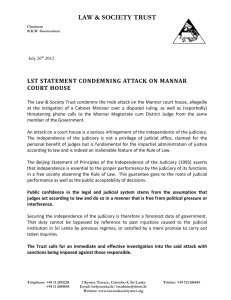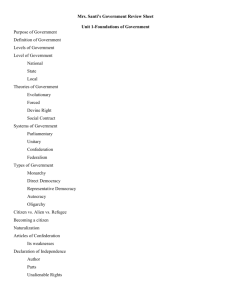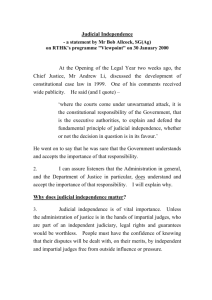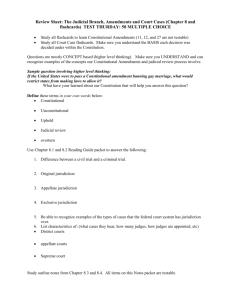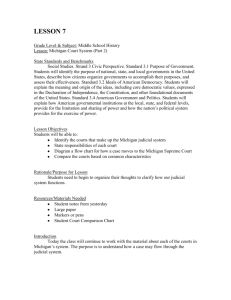DOC - Supreme Court
advertisement
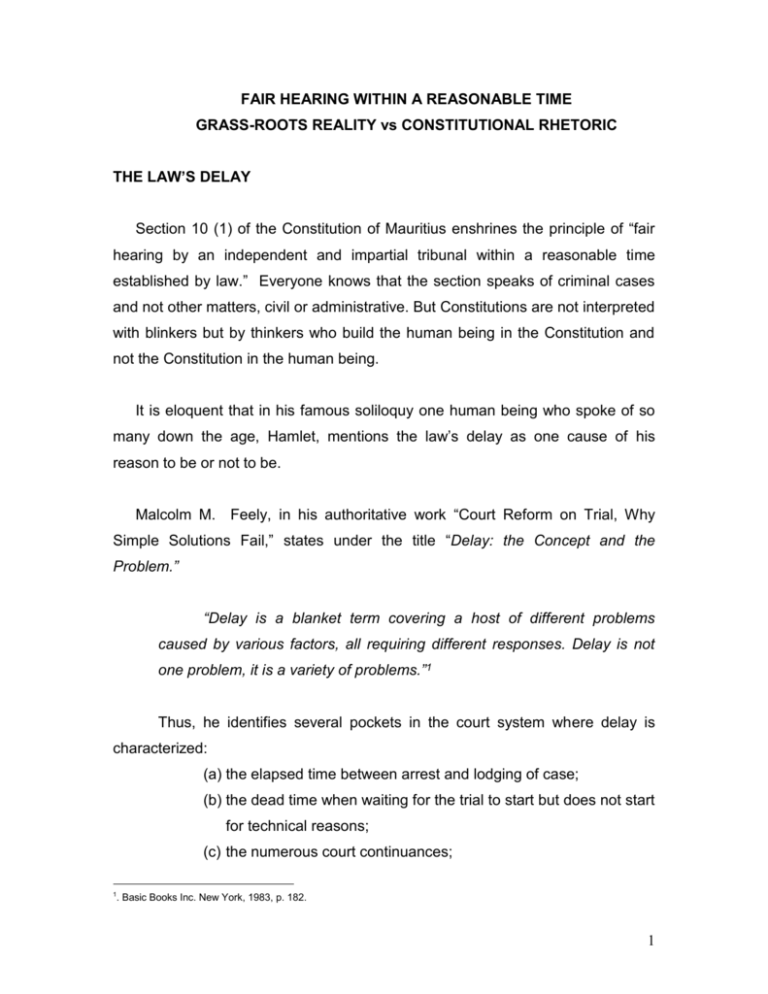
FAIR HEARING WITHIN A REASONABLE TIME GRASS-ROOTS REALITY vs CONSTITUTIONAL RHETORIC THE LAW’S DELAY Section 10 (1) of the Constitution of Mauritius enshrines the principle of “fair hearing by an independent and impartial tribunal within a reasonable time established by law.” Everyone knows that the section speaks of criminal cases and not other matters, civil or administrative. But Constitutions are not interpreted with blinkers but by thinkers who build the human being in the Constitution and not the Constitution in the human being. It is eloquent that in his famous soliloquy one human being who spoke of so many down the age, Hamlet, mentions the law’s delay as one cause of his reason to be or not to be. Malcolm M. Feely, in his authoritative work “Court Reform on Trial, Why Simple Solutions Fail,” states under the title “Delay: the Concept and the Problem.” “Delay is a blanket term covering a host of different problems caused by various factors, all requiring different responses. Delay is not one problem, it is a variety of problems.”1 Thus, he identifies several pockets in the court system where delay is characterized: (a) the elapsed time between arrest and lodging of case; (b) the dead time when waiting for the trial to start but does not start for technical reasons; (c) the numerous court continuances; 1 . Basic Books Inc. New York, 1983, p. 182. 1 (d) the needless court appearances or missed appearances; (e) the frustration over a variety of apparent inefficiencies of the system. The American Judicature Society comments: “Two years of research has convinced us that simply viewing delay as one problem is not very helpful …. We prefer to view delay as a symptom of other problems that exist within a court system.” As regards responsibility for the state of affairs, it concludes – “Our research indicates that all actors may be responsible for unnecessary case processing time.” (emphasis added) When he concluded “all actors,” he meant all actors including parties who complain and parties who do not. THE PROBLEM OF COURT DELAY IS THE CONSTITUTIONAL PARADOX OF THE AGE The Judiciary is that arm of the State whose institutional responsibility it is to render the rhetoric of human rights into a reality at the grassroots. 2 From this flows the constitutional paradox of the age. The Judiciary pillories the Legislature and the Executive for human rights violations. But when it comes to its own institutional ability to do it, it pleads default. Many would not agree with me. But . Pierre Olivier Jj. In “Parliamentary Supremacy and Judicial Independence, A Commonwealth Approach,” at p. 55: “It is trite that the American, Canadian and European models of government, limited by a human rights regime and enforced by an independent judiciary, serve the interests of society better than any other system.” He adds: “Such models guarantee the most cherished and valuable of all rights viz. the fundamental rights of people. By protecting the rights of all equally and equitably, they ensure a large measure of peace and tranquility amongst individuals and groups, including minority and ethnic groups.” 2 2 they would none the less agree with what Benedict S. Alpen & Lawrence T. Nichols has stated: “It has been our habit to acclaim our noble pretensions at the same time that we lament the failures in practice. The pretensions sound increasingly empty and unconvincing and our expectations fall far beneath them.”3 From this flows other paradoxes at the grass-roots. The credential of any democratic government today is the efficiency and the effectiveness of its justice system which includes its ability to hand out timely decisions which are also effective. Just as democracy is today seen to be much more than the concept of the nation state, much more than the concept of fair and free elections, much more than adherence to Separation of Powers, much more than constitutionalism and the rule of law, likewise the justice system is much more than section 10 of the Constitution, much more than handing out judgments for cases brought to court, much more than writing erudite judgments, much more than controlling the professions, much more than sentencing convicts, much more than applying the law and exercising judicial authority. Never before in the history of the world has society moved so exponentially than our age. From the time the cavemen discovered fire. The courts and the culture that served the society of oil lamps, bullock carts and thatched houses are no longer able to serve our present society of sky scrapers, towers, glass houses and satellites. The world has flattened. Along with it has come the complexities and the contradictions of the age. For example, the insecurity of the past underdevelopment seemed to have brought us better security and the security of the present development seem to have brought greater insecurity. Our courts today are expected to continue giving the confidence to the public that the public should continue believing in its justice system. Beyond the Court Room, p. 26, Canada,USA, Lexington Books, 1982. 3 The public, did you say? The reality of our courts is that our citizens will not agree with us that we ever existed for them. Our court system was designed to keep the British Empire going. Thereafter, when we adopted a Constitution, we changed the bottle but barely the content. We primarily existed for the Bar and the Bench and only secondarily for the grass-roots and the underdogs, some would argue. One morning I was fixing a case for continuation before my court. Both counsel gave me a date in 2009 as the only available date in their Diary. Before a whole court well welled of people, I stated: “There is a myth that it is the court that delays matters. You see it is counsel who delay matters. I could give you a day next week.” That evening I was attending a Conference on ADR where we heard another anecdote from a foreign Queen’s Counsel comprising of two just two exchanges between the Bar and the Bench: Judge: Mr Blogg, can you tell me how long your case would last. Mr Blogg: It depends entirely upon you, me Lord.” WHAT IS THE ROOT CAUSE OF COURT DELAY? THE REALITY OF INSTITUTIONAL UNIQUENESS Those who have authoritatively studied this very specialist area has concluded why simple solutions fail in the court system. They argue with conviction that the reason lies in an institutional problem. Each player in the court system has his own interest to watch. There is no single individual with a leadership role to gear the system to produce institutional 4 expediency. The Judge does no more than referee, the defence lawyer does no more than strategize for his client, the prosecutor does no more than present facts, the clerk does no more than process the papers. The name of the game is lame and laches. That is the reason. More specifically, there is no board room which sits periodically to assess performance, corporate activities have no corporate focus for setting specific objectives and meeting targets within a time-frame. The constitutional provision is airy fairy: “a fair hearing by an independent and impartial tribunal within a reasonable time“ which to some may mean everything and to others next to nothing. THE PROFESSIONAL REALITY With the institutional reality, we add the professional reality. Those most resistant to change are the professionals themselves. As one researcher put it: “In most instances, not only is there no general desire to change but there is a systemic tendency to retain the status quo …” – Raymond T. Nimmer quoted by Malcolm M. Feely, ibid. Yet few of us do not know what we have to do. As Benedict S. Alpen & Lawrence T. Nichols, “Few of us base our criticism of the courts on knowledge gained through direct personal experience, yet few of us are without an opinion as to what is wrong with our courts and what should be done to improve them.” 4 4 . Beyond the Court Room, Canada,USA, Lexington Books, 1982. 5 THE BIG QUESTION IS HOW TO REVERSE THE TREND AND MAKE THE HUMAN RIGHTS PROVISIONS A REALITY. Serious research in the matter shows that the first requirement is make someone sit in the driver’s seat with clear vision, mission, goals and objectives: both longterm and short-term. Between the Judge, the Court Manager, Counsel, Legislature as to who should sit in the driver’s seat, the obvious answer is the Judiciary that is the Judge. The Judge has to take the professionals in the dynamics of change by the scruff of the neck. Take on board - (a) the Professions individually and through the Bar, the Law Society; (b) the Para-legals individually and through their Unions or Associations; (c) the Court Users through Ad Hoc or established NGOs; (d) the written and the spoken Press. 6 POLICY COMMITMENT Court Personnel, accordingly, have a responsibility to adopt a Court Policy Commitment for fulfilling that role and in the process modernizing the justice system by the adoption of tools and techniques, state of the art technology and apply the sciences necessary to live up to the expectations of a democratic state. If management is left to judicial officers, it is believed that we shall end up mediocre managers as well as mediocre judicial officers inasmuch as both are specialist jobs. If it is left to the Executive, they will be perceived as having an executive agenda not consistent with the role of the independence of the judiciary. Administration of the courts to-day is a specialized and specialist profession in the Executive branch of the State, if under the leadership of the courts. In this way both the science of judging and the science of managing the process are reconciled without hurting the fundamental principles of any of the three arms of the State. The elected Legislature decides the quality of justice it wants and pays for. The Executive creates the dynamic, innovative and proactive conditions, implements the policies and services the Judiciary. The Judiciary for its part delivers justice according to law to play fully its constitutional role within the State as a trustee and guardian of the rights of the citizens. Court service to the community thus becomes a matter of public scrutiny and accountability. Drawing clear demarcation lines between purely administrative, quasiadministrative and judicial activities is another way of speedy trial. The principles of modern management demands that these functions be properly defined to avoid any confusion of roles. The service of summons, the preparation of transcripts, t 7 THE NEW CONCEPTS IN JUDICIAL ADMINISTRATION Modern court management include the introduction of such concepts as demarcation of responsibility between administrative matters, quasi-judicial matters and judicial matters. The Court system does not exist for the Bench and the Bar but for the citizen. Accordingly, the concept of court service to the community should be developed. Such sensitive matters as delay and perception of delay should be resolved scientifically such as by the adoption of case management, case-flow management, differentiated case management. It is not enough to make judicial decisions available to the Bench and the Bar. Critical data that serve the cause of modern management have to be identified and gathered for an intelligible and purpose use in the legal and judicial system. The conclusions have to be published and systems have to be devised so that corrective actions may be taken with the collaboration of the Powers That Be. PRO-ACTIVE ROLE OF COURT ADMINISTRATORS The modern court administrator is a key player in each and every aspect enumerated above. He sets up his vision, his mission, his goals and his objectives after consulting his judicial head. He drives the process no matter whether the issues relate to case flow, to delay reduction, to the application of orders, the calling of formal and informal meetings with the players involved or with members of the local community. INDIGENIZATION OF CASE FLOW MANAGEMENT It is the duty of the court administrators to attempt to take up all the issues with the judicial officers of the Court with a view to creating the conditions proper for the formulation of a proper system of judicial administration indigenous to the national judicial system, under the leadership and control of the Judicial Officer. 8 PRIORITIZATION IN PROJECTS The Court Administrator should be committed to making a SWOT analysis of his court, imaginative in developing projects and prioritizing between them for progressive innovation and improvements. THE ISSUE OF DELAY AND THE ROLE OF THE PLAYERS IN THE MACHINERY The problem of delay should demand his special attention. An exercise should be carried out to identify the various reasons for delays. Thereafter, dynamic methods should be utilized not only to resolve the problem of back-log but also to ensure a smooth disposition of cases as a whole in the courts. The assistance of all the players in the machinery of justice should be secured: such as the Attorney, the Barrister, the Prosecutor, the Court User will be sought towards the search of a solution to the problem of delay and the smooth disposition of cases in the courts. There should be an avoidance for indiscriminate loading of cases of which the chances of immediate disposal are remote. Only such cases should be fixed which are ready for trial. Conversely, all cases of which the chances of disposal are remote should be considered with the seriousness they deserve and efforts should be spent to expedite them as quickly as possible, within a scheduled time frame. The hiccups concerning each category should be studied and measures taken to resolve them. DIFFERENTIATED CASE MANAGEMENT There should be a system of Differentiated Case Management so that cases should be fixed in terms of their likely duration: type, nature and disposability. In this regard, appropriate tracks should be introduced along the 9 principle of “courses for horses” such as Fast Track, Normal Track, Complex Trials. STRICT POLICY AGAINST POSTPONEMENTS A strict policy against postponements should be adopted and sanctions imposed where the postponements sought are unwarranted. GUIDE-LINES AND TIME SCHEDULES Guidelines and time schedules should be set for every critical activity in the court system. These should be published and monitored. Regular meetings should be held to ensure that they work properly. The staff should be made to own the decisions relating to the guide-lines and time schedules so that they may work. MEETINGS AND PERIODIC REVIEW Meetings with all the players should be a regular feature in the Court Administration and the methods used should be periodically reviewed and, where necessary, modified for corrective or remedial actions. INTELLIGIBLE USE OF STATISTICS Simple Statistics should be gathered and used with a view to assessing daily progress or regress, as the case may be, of the court in the day-to-day disposition of cases. Corrective measures, where necessary, should be taken as soon as practically possible to restore performance to set goals and objectives. 10 GREATER PROFESSIONALISM IN COURT ADMINSTRATION Court Administration should be regarded and pursued as a specialized profession demanding all modern techniques of sound management principles. Adequate exposure, local and international, should be given to court administrators with proper certification for attendance and participation and ultimate recognition in promotional and specialist development chances in the career structure. SOME SOLUTIONS FOR RESOLVING DELAY IN THE COURT SYSTEM: (A) JUDGES TO PERCEIVE MARSHALLING THEIR ROLES FOR REDUCING EFFORTS AS LEADERS DELAY IN TAKING PROFESSIONALS ON BOARD; (B) COURTS a. TO BE SERIOUS WITH FIXTURES AND NOT TO ALLOW EASY DISPLACEMENTS; b. TO ADOPT RIGID POLICY TO DEAL WITH CONTINUATIONS; c. TO LIMIT ISSUES WITH THE ASSISTANCE OF COUNSEL; d. TO CONTROL CALENDARS; e. TO APPOINT FULL-TIME ADMINISTRATORS; f. TO MAKE USE OF COMPUTERIZED INFORMATION SYSTEMS; g. TO ADOPTION OF MODERN OFFICE MANAGEMENT TECHNIQUES AND SYSTEMS; h. ADOPT CASEFLOW MANAGEMENT TOOLS AND TECHNIQUES. 11 In the Charter of Fundamental Rights of the European Union, Article 47 speaks of the right to an effective remedy and to a fair trial in the following terms: “Everyone whose rights and freedoms guaranteed by the law of the Union are violated has the right to an effective remedy before a tribunal in compliance with the conditions laid down in this Article. Everyone is entitled to a fair and public hearing within a reasonable time by an independent and impartial tribunal previously established by law. Everyone shall have the possibility of being advised, defended and represented. Legal aid shall be made available to those who lack sufficient resources insofar as such aid is necessary to ensure effective access to justice.” CONCLUSION Delay is a component of fair trial and fair trial is a composite term and the composite term includes intra-institutional and inter-institutional considerations. To deal with the question of delay in then court system in patchwork measure is dealing with the symptoms and not the root causes. An analogy may be brought to resolving delay in reaching work early morning. It demands imagination: opening up new roads, re-directing traffic, staggering traffic. That analogy cannot be brought too far because traffic delay occurs at peak times. The delays in courts have become systemic. Justice S.B.Domah June 2008 12


